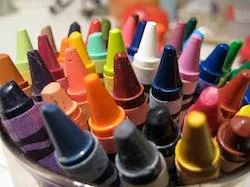Colorful Kindergarten Lessons Throw Color-Blind Kids Off Their Game
/https://tf-cmsv2-smithsonianmag-media.s3.amazonaws.com/filer/20130205081019279913127_21afbc6c95.jpg)
Remember when everything was color-coded? Back when you sat on your purple carpet square, the days of the weeks were on the wall (Sunday was red, Monday was orange), and your life centered around making sure that you got your favorite crayon at coloring time? Imagine all that, but being color-blind. This is what color-blind kids go through early in life, and it’s not a trivial issue. Joss Fong reports for Scienceline on just how big a challenge school can be for color-blind kids:
An estimated one in 12 boys and one in 200 girls in the United States have a red-green color vision deficiency (CVD). This comes from a hereditary gene mutation that disables or alters some of the light-sensitive cone cells in their eyes, making it difficult to distinguish certain greens, reds, browns, oranges and yellows. While this is only a minor obstacle for most affected children, it does put them at a disadvantage in certain contexts – especially at school. Despite the prevalence of colorblindness, however, there are few systems in place to minimize the confusion and frustration that these students may experience in the classroom.
And it’s not like kids can point out to anyone the reason they’re having trouble. They often don’t know they’re color-blind at all. “To me, my color are the only colors,” remarked William Jeffrey Harding, who as a kid failed several aptitude tests that asked questions like “How many green crayons are in the picture? How many red?”
Finding out that kids are color-blind isn’t necessarily easy, or obvious. Very few states require screening for color blindness. And even in places where teachers know that they’ve got color-blind students, most educational materials aren’t designed to deal with the problem. So they use the traditional ones, says Fong:
Even if teachers know which of their students have a color vision deficiency, they likely use materials that were not designed to be accessible to colorblind children. Researchers at the Technical University of Catalonia, also in Spain, examined 24 of the most commonly used textbooks for five to seven year old children in the region and found that 10 percent of the tasks in the math books “would be very difficult or impossible to solve” for colorblind students. The authors found that “efforts to design CVD-friendly teaching materials and resources are scarce.” A search of the ERIC education research database indicates that this type of analysis has not been conducted for textbooks in the U.S.
Here’s a box of crayons:

And here’s what it looks like to a color-blind kid (roughly, there are all sorts of forms of color blindness, so online simulators can only do so well):

And here’s a question from a text book (highlighted in this study about whether or not text books are suitable for color-blind kids):


Clearly, being color-blind isn’t simply going to mean making less pretty crayon drawings. It can make teachers think that kids have trouble learning or following instructions. Imagine if some of the most famous color blind people out there, like Meat Loaf and Paul Newman and Bill Clinton, had been held back because of their color blindness. In fact, Clinton and Bob Dole both asked for a special accommodation in the 1996 presidential debate, writes The Hill:
The Encyclopedia of Genetic Disorders and Birth Defects writes that during the 1996 presidential debates both then-President Bill Clinton and former Sen. Bob Dole (R-Kan.) needed special lights to know when they were appearing on camera: ‘ “Both have inherited red/green color vision confusion and would have had difficulty with signals based on individual colored lights, so a system using three lights was used.’
For teachers, understanding and recognizing color blindness is the first step. Becoming the president takes a bit more time.
More from Smithsonian.com:
Was Vincent van Gogh Color Blind? It Sure Looks Like It
Hey, Mr. White, that’s the wrong color for that
/https://tf-cmsv2-smithsonianmag-media.s3.amazonaws.com/accounts/headshot/Rose-Eveleth-240.jpg)
/https://tf-cmsv2-smithsonianmag-media.s3.amazonaws.com/accounts/headshot/Rose-Eveleth-240.jpg)